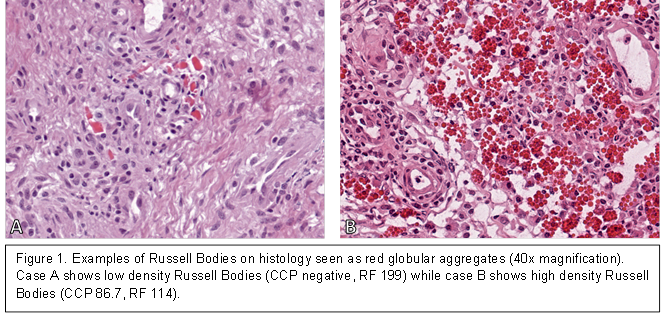Session Information
Date: Monday, October 22, 2018
Title: Rheumatoid Arthritis – Diagnosis, Manifestations, and Outcomes Poster II: Diagnosis and Prognosis
Session Type: ACR Poster Session B
Session Time: 9:00AM-11:00AM
Russell Bodies and Serological Status in Rheumatoid Arthritis
Background/Purpose:
Russell bodies (RBs) are globular aggregates of immunoglobulin produced by plasma cells and identified both within the plasma cells (PCs) and free in inflamed tissues.1 It has been suggested that RBs form when antibody production surpasses protein transportation mechanisms in the cell, possibly indicating heightened production of the antibodies. Rheumatoid factor (RF) and anti-cyclic citrullinated peptide (aCCP) are antibodies commonly identified in serum of patients with rheumatoid arthritis (RA). In some patients with RA undergoing arthroplasty, synovial tissue is highly inflamed and the histologic features include the presence of plasma cells with and without RBs. The molecular features and clinical significance of RBs are unknown. Here we test the hypothesis that RBs associate with the degree of positive serology in RA.
Methods:
Tissue samples from 191 RA patients undergoing total hip, knee, shoulder, or elbow arthroplasty were scored for the proportion of PCs, the presence of binucleate plasma cells (bnPC), and RBs. Serological test results for RF and aCCP were collected. Logistic regression was used to calculate an odds ratio for positive serological results with the presence of RBs seen histologically. The concordance of bnPCs and RBs was evaluated.
Results:
Of the 191 RA patients, 170 (89%) cases had suitable synovium for histologic characterization. Of the 170 synovial samples assessed, 37 (22%) contained RBs. Demographics (age, sex, joint replaced) of RB positive cases were similar to RB negative cases. Clinical measures (tender and swollen joint counts, patient global, and MD global) were similar between groups. Erythrocyte sedimentation rate (ESR) and C-reactive protein (CRP) levels were significantly elevated in the RB-positive cohort (p<0.001). Significantly more RB-negative patients were in DAS28-ESR remission (p=0.024). RF and aCCP status were both significantly different between groups (p<0.001 and p=0.024, respectively) as well as the proportion of patients with both RF and aCCP positive results (p<0.001). The unadjusted odds ratio of having a positive serological test (RF or CCP) when RBs are found on histology is 3.94 (1.13-13.72, p=0.031). There was good concordance between bnPCs and RBs (kappa coefficient [95% CI], 0.62 [0.48 – 0.75]).
Conclusion:
The presence of RBs in synovial histology is not specifically incorporated into most synovial pathology scoring schemes. This study suggests that the presence of RBs is a significant histological finding that parallels serological status in RA, perhaps in patients with undiagnosed or untreated disease. Additionally, the association of RBs and bnPC may suggest a mechanistic connection that stands to be further explored.
References:
1. Blom J, Mansa B, Wiik A. Acta Pathologica Microbiologica Scandinavica. 1976 84A: 335-349.
To cite this abstract in AMA style:
McNamara MA, Goodman SM, Donlin LT, Orange D, Mirza SZ, Szymonifka J, Figgie MP, Bykerk VP, DiCarlo EF. Russell Bodies and Serological Status in Rheumatoid Arthritis [abstract]. Arthritis Rheumatol. 2018; 70 (suppl 9). https://acrabstracts.org/abstract/russell-bodies-and-serological-status-in-rheumatoid-arthritis/. Accessed .« Back to 2018 ACR/ARHP Annual Meeting
ACR Meeting Abstracts - https://acrabstracts.org/abstract/russell-bodies-and-serological-status-in-rheumatoid-arthritis/

